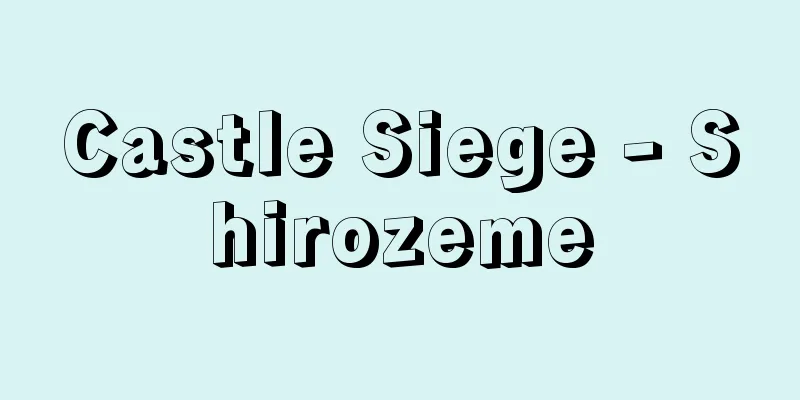Official Room - Goyoubeya

|
Generally, it refers to the office (workroom) in the palace of the Edo Shogunate's chief advisors, such as the chief advisor, senior councilor, and junior councilor. The rooms were divided into two sections, with the senior councilor in the upper room (Kaminoma) and the junior councilor in the lower room (Shimonoma), and the chief advisor worked in a separate area in the upper room (Kaminoma). Until the first rule of the fifth shogun, Tokugawa Tsunayoshi, the chief advisors' office was called the Bugyosho and was located in a room near the Goza-no-ma, the shogun's inner room. However, in 1684 (Jokyo 1), when the chief advisor Masatoshi Hotta was murdered by the junior councilor Masayasu Inaba near the magistrate's office, the magistrate's office for the shogun's close aides was abolished out of fear of danger to the shogun, and the office of the elder statesman was moved to the table room, far from the throne room, and it came to be called the Goyoheya. As a result, chamberlains and other aides came to be placed between the isolated elder statesman and the shogun as intermediaries in government affairs, giving rise to the so-called aide-de-camp politics. Incidentally, only the innermost secretaries, who acted as the secretary to the elder statesman, were allowed to enter the Goyoheya, and all other government officials were prohibited from entering. In some feudal domains, the offices of the elder statesmen were called the Goyoheya. [Kitahara Akio] Source: Shogakukan Encyclopedia Nipponica About Encyclopedia Nipponica Information | Legend |
|
一般には江戸幕府の大老、老中、若年寄ら閣老の殿中における詰所(執務室)をいう。部屋は2局に分かれ、上之間(かみのま)には老中、下之間には若年寄が詰め、大老は上之間の入側上座に一画し、そこで執務した。5代将軍徳川綱吉(つなよし)の初政まで、閣老の詰所は奉行所(ぶぎょうしょ)と称し、奥の将軍の居室である御座之間の近室に置かれていた。しかるに、1684年(貞享1)奉行所の傍らで大老堀田正俊(まさとし)が若年寄稲葉正休(まさやす)に殺害されたのを契機にし、将軍の身に危険が及ぶのを恐れて、将軍側近の奉行所は廃止され、閣老の執務室は御座之間からはほど遠い膳立(ぜんだて)之間に移されて、そこを御用部屋と称するようになった。この結果、隔離された閣老と将軍との間には、政務の取次役として側用人(そばようにん)や側衆らが介在するようになり、いわゆる側近政治を生み出すことになった。ちなみに、御用部屋に出入りを許されたのは、閣老の秘書官たる性格をもつ奥右筆(おくゆうひつ)のみに限られ、諸役人の入室はいっさい禁止された。また諸藩のなかには、家老らの詰所を御用部屋とよぶところもあった。 [北原章男] 出典 小学館 日本大百科全書(ニッポニカ)日本大百科全書(ニッポニカ)について 情報 | 凡例 |
Recommend
Igakusa - Igakusa
...It is distributed west of Aichi Prefecture in ...
Mechanical industry
An industry that produces all kinds of machinery,...
Newspaper novels - shinbun shosetsu
A novel serialized in a newspaper. [Haruo Takahas...
Horse opera
The other type of western was the Bronco Billy se...
chapada
...The state capital is Goiânia. Most of the stat...
Platypodidae
…General term for insects of the family Platypodi...
belay
…For winter climbing, sturdy, warm climbing shoes...
Arnulf von Metz
He was the teacher of Dagobert I from around 580 t...
Qiang people (Qiang tribe) - Qiang tribe (Qiang tribe)
A northern nomadic people who have lived widely in...
Hitzig, E.
...Gall's phrenology lost momentum due to the...
Peacock turtle - Peacock turtle
…A turtle of the family Erymidae. It includes 12 ...
Banquet song - Enkyoku
The name in literary history of a type of medieval...
Phonocardiogram
...The development of superior phonocardiographs ...
Cante
...Also, the guitar, which had traditionally been...
Atagawa [Hot spring] - Atagawa
Located in Higashiizu-cho, Kamo-gun, Shizuoka Pref...









